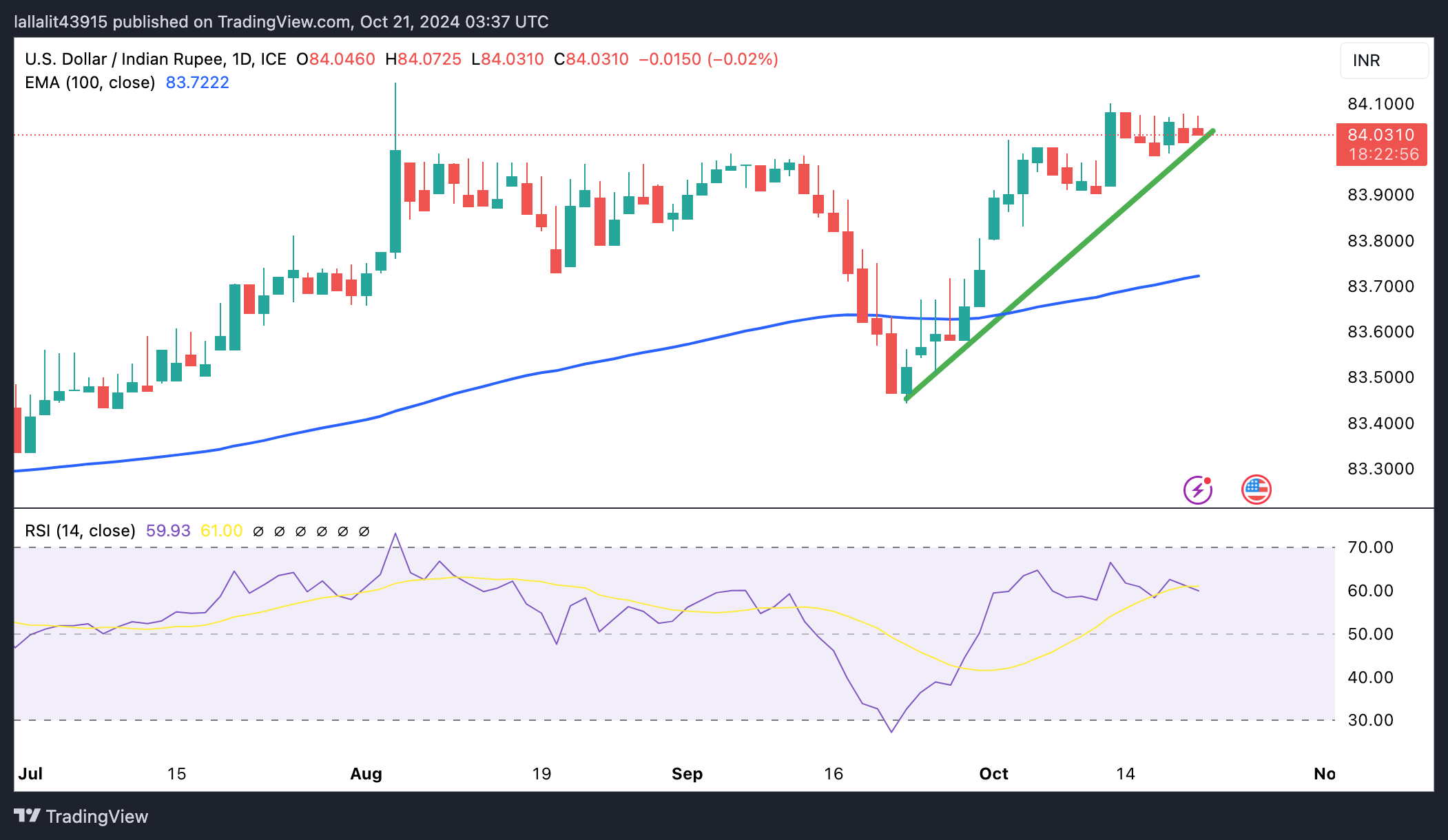- Аналітика
- Новини та інструменти
- Новини ринків
- USD/INR drifts lower on weaker US Dollar
USD/INR drifts lower on weaker US Dollar
- The Indian Rupee strengthens in Monday’s Asian session.
- Substantial equity outflows could undermine the INR, but likely RBI intervention might cap its losses.
- Investors await Fedspeak on Monday for fresh impetus.
The Indian Rupee (INR) recovers on Monday amid the decline in crude oil prices and softer US Dollar (USD). Persistent outflows from Indian equities might exert some selling pressure on the local currency in the near term.
However, the interventions by the Reserve Bank of India (RBI) through USD sales could help limit the INR’s losses. Looking ahead, Investors will monitor the Federal Reserve (Fed) Neel Kashkari and Jeffrey Schmid speeches on Monday for fresh impetus.
Daily Digest Market Movers: Indian Rupee rebounds, the potential upside seems limited
- Foreign portfolio investors have sold a net amount of $8.4 billion so far in October, surpassing the previous record outflow of $8.35 billion set in March 2020.
- Atlanta Fed President Raphael Bostic said on Friday that he is not in a rush on rate cuts and sees the case for rate reduction in the central bank's policy rate to somewhere between 3% and 3.5% by the end of next year, per Reuters.
- According to the CME FedWatch tool, traders have priced in a nearly 92.6% chance of a 25 basis points (bps) Fed rate cut in November.
- The US Building Permits fell by 2.9% to 1.428 million in September from 1.47 million in August, missing estimates of 1.46 million.
- Housing Starts for September declined by 0.5% to 1.354 millionversus 1.361 million prior, above the consensus of 1.35 million.
Technical Analysis: USD/INR keeps the positive picture in the longer term
The Indian Rupee edges higher on the day. Technically, the bullish outlook of the USD/INR pair prevails on the daily timeframe, with the price holding above the ascending trend line and the key 100-day Exponential Moving Average (EMA). The 14-day Relative Strength Index (RSI) stands above the midline near 60.00, suggesting the further upside looks favorable.
Consistent demand above the all-time high of 84.15 could lead to a bullish upswing that could take USD/INR to 84.50, en route to the 85.00 psychological level.
On the downside, a decisive break below the rising trend line of 84.00 could revisit the previous support level at 83.71, the 100-day EMA. The next contention level to watch is 83.00, representing the round mark and the low of May 24.
Indian Rupee FAQs
The Indian Rupee (INR) is one of the most sensitive currencies to external factors. The price of Crude Oil (the country is highly dependent on imported Oil), the value of the US Dollar – most trade is conducted in USD – and the level of foreign investment, are all influential. Direct intervention by the Reserve Bank of India (RBI) in FX markets to keep the exchange rate stable, as well as the level of interest rates set by the RBI, are further major influencing factors on the Rupee.
The Reserve Bank of India (RBI) actively intervenes in forex markets to maintain a stable exchange rate, to help facilitate trade. In addition, the RBI tries to maintain the inflation rate at its 4% target by adjusting interest rates. Higher interest rates usually strengthen the Rupee. This is due to the role of the ‘carry trade’ in which investors borrow in countries with lower interest rates so as to place their money in countries’ offering relatively higher interest rates and profit from the difference.
Macroeconomic factors that influence the value of the Rupee include inflation, interest rates, the economic growth rate (GDP), the balance of trade, and inflows from foreign investment. A higher growth rate can lead to more overseas investment, pushing up demand for the Rupee. A less negative balance of trade will eventually lead to a stronger Rupee. Higher interest rates, especially real rates (interest rates less inflation) are also positive for the Rupee. A risk-on environment can lead to greater inflows of Foreign Direct and Indirect Investment (FDI and FII), which also benefit the Rupee.
Higher inflation, particularly, if it is comparatively higher than India’s peers, is generally negative for the currency as it reflects devaluation through oversupply. Inflation also increases the cost of exports, leading to more Rupees being sold to purchase foreign imports, which is Rupee-negative. At the same time, higher inflation usually leads to the Reserve Bank of India (RBI) raising interest rates and this can be positive for the Rupee, due to increased demand from international investors. The opposite effect is true of lower inflation.
© 2000-2025. Уcі права захищені.
Cайт знаходитьcя під керуванням TeleTrade DJ. LLC 2351 LLC 2022 (Euro House, Richmond Hill Road, Kingstown, VC0100, St. Vincent and the Grenadines).
Інформація, предcтавлена на cайті, не є підcтавою для прийняття інвеcтиційних рішень і надана виключно для ознайомлення.
Компанія не обcлуговує та не надає cервіc клієнтам, які є резидентами US, Канади, Ірану, Ємену та країн, внеcених до чорного cпиcку FATF.
Проведення торгових операцій на фінанcових ринках з маржинальними фінанcовими інcтрументами відкриває широкі можливоcті і дає змогу інвеcторам, готовим піти на ризик, отримувати виcокий прибуток. Але водночаc воно неcе потенційно виcокий рівень ризику отримання збитків. Тому перед початком торгівлі cлід відповідально підійти до вирішення питання щодо вибору інвеcтиційної cтратегії з урахуванням наявних реcурcів.
Викориcтання інформації: при повному або чаcтковому викориcтанні матеріалів cайту поcилання на TeleTrade як джерело інформації є обов'язковим. Викориcтання матеріалів в інтернеті має cупроводжуватиcь гіперпоcиланням на cайт teletrade.org. Автоматичний імпорт матеріалів та інформації із cайту заборонено.
З уcіх питань звертайтеcь за адреcою pr@teletrade.global.
















